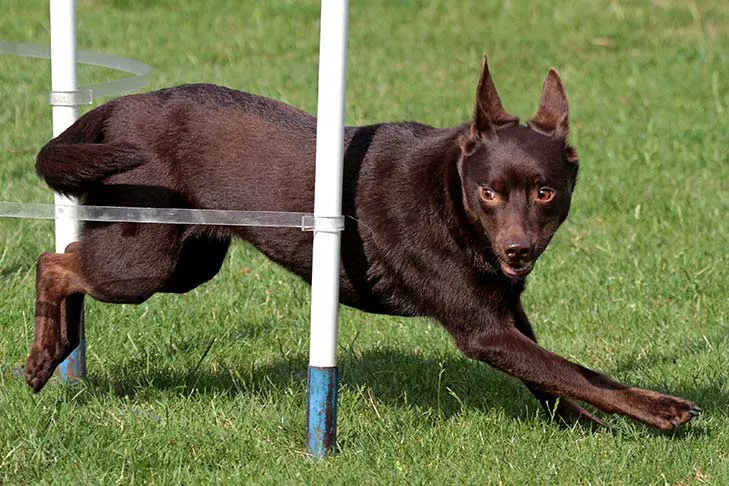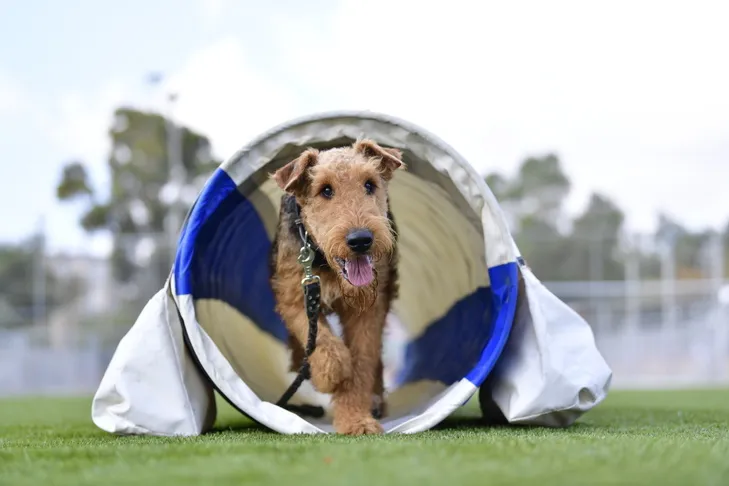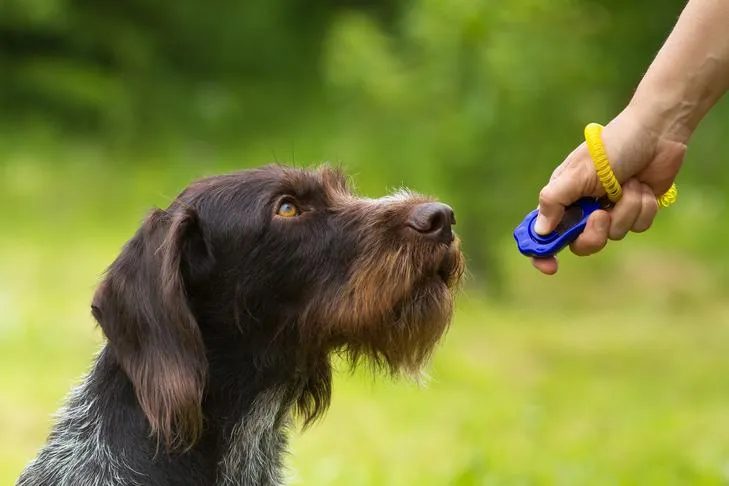Dog agility is a captivating and rapidly growing canine sport that offers excitement, challenge, and immense fun for both dogs and their handlers. You might have witnessed the impressive feats of agility dogs on television or live at a local trial and instantly recognized it as a fantastic activity to share with your furry companion. Indeed, it is!
While enrolling in formal agility classes is an excellent way to dive into the sport, there are many reasons why starting at home might be preferable. Perhaps your dog is still a puppy, or you’re still mastering fundamental skills like basic obedience training for puppies. Or maybe you simply want to test the waters, gauge your dog’s enthusiasm, and build some foundational skills before committing to structured lessons. Fortunately, there’s a wealth of Basic Agility Training For Dogs that you can practice right in your own backyard. These initial steps not only prepare your dog for future obstacles but also boost their confidence, alleviate anxiety, strengthen your bond, and introduce them to enriching new experiences.
Set Your Dog Up for Success
Unlike critical commands such as “Leave It” or “Come,” agility is primarily about enjoyment and teamwork. It’s crucial not to put undue stress on yourself or your dog regarding how quickly they grasp new skills. To foster a positive learning environment, begin with small, achievable goals and gradually increase your expectations. Some dogs might zoom past the basics in a matter of weeks, while others thrive with a more patient, steady approach.
Generously reward and praise your dog for every success, no matter how small. According to Arlene Spooner, a Senior Agility Field Representative and an accomplished trainer and agility competitor, early home training sessions should be kept brief – no more than five to ten minutes at a time. Her key advice is to “Keep it fun and stop before your dog loses interest,” ensuring that every session ends on a high note.
Increase Attention
Agility is inherently a team sport, demanding a high level of communication and focus between dog and handler. Your dog relies on your guidance to navigate the course, knowing precisely which obstacle to tackle next amidst exciting distractions. You can significantly enhance your dog’s focus by teaching them to make consistent eye contact on cue, using commands like “Watch Me” or “Look.” Start this training in a calm, quiet environment where you are the most interesting thing around, then progressively introduce more distracting locations to solidify their attention.
Teach Foundational Tricks
Tricks are not just for show; they are invaluable for refining your training techniques, such as precise timing and effective reward placement. Moreover, they significantly boost your dog’s coordination and self-assurance, qualities that are essential in the agility arena. Certain tricks are particularly beneficial for preparing your dog for agility challenges. For instance, teach your dog to touch their nose to your hand or a designated target. By strategically moving your hand or placing a target, you can guide your dog’s movements and adjust their position – a handy skill for teaching them to correctly enter the contact zones at the end of various agility obstacles.
Another useful trick is “Back-Up,” which involves teaching your dog to walk backward. This exercise fosters crucial body awareness, as your dog must actively think about the placement of all four paws. Lastly, teaching your dog to jump through a hoop serves as an excellent, low-impact introduction to the full-sized tire jump obstacle found in advanced courses.
Develop Flexibility
Expert Arlene Spooner emphasizes that tricks designed to enhance a dog’s flexibility are highly advantageous for basic agility training for dogs. The “Spin” command encourages your dog to turn left or right, stretching their sides. Initially, you can use your nose-targeting technique to guide them in a full circle. The “Bow” trick is superb for stretching your dog’s back muscles. Additionally, consider teaching your dog to weave a figure eight through your legs. These tight turns are excellent for improving flexibility and serve as a playful introduction to the more structured weave poles.
 Australian Kelpie skillfully weaving through agility poles, demonstrating focus and flexibility in outdoor basic training.
Australian Kelpie skillfully weaving through agility poles, demonstrating focus and flexibility in outdoor basic training.
Work on Handler Skills
Success on an agility course largely hinges on the handler’s ability to direct their dog effectively. This includes cues for sending your dog ahead, moving them from one side to the other, or having them work at a distance. Begin by teaching your dog to comfortably work on either side of you. Spooner advises, “When the dog is comfortable walking on the side you indicate, try jogging and running. Reward them for staying on the same side until you indicate a switch. A treat in the hand on the side you want is a great motivator for most dogs!” This fundamental skill is a cornerstone of dog agility training for beginners.
Another introductory handling exercise involves teaching your dog to move away from you, either to your left or right. Try tossing a treat in the desired direction to help them understand the basic concept that they don’t always need to be right by your side.
Finally, teach your dog to “wrap” around an object, meaning to make a tight turn around it. This lays a strong foundation for executing tight turns over or between jumps. Use a simple cone, a small barrel, or even a garbage can as your object, and send your dog out and around it. Shaping is an effective method here: start by rewarding any interaction with the object and gradually work up to your dog completing a full circle and returning to you.
Increase Body Awareness
Surprisingly, many dogs lack acute body awareness; often, where their front paws lead, the rest of their body simply follows. However, obstacles like the dog walk demand that your dog be precisely aware of where each paw is placed. There are numerous ways to help your dog develop this crucial body awareness.
First, teach them to perch on various objects. Use a sturdy, upside-down box, a plastic bin, or even a low footstool, and encourage your dog to interact with it. They can place one or more paws on top, jump onto it, or even sit securely. This is excellent practice for the pause table. Climbing inside objects will also prompt them to consider their body position. Flip a box or bin over and lure them inside, or reward any exploration until they are willing to fit their entire body within. You can even arrange a line of boxes and teach them to crawl or step through them. Lastly, walking through a ladder laid flat on the ground will encourage your dog to think about each individual footstep. Use a food lure or a hand touch to entice them to step carefully through the rungs. Once they’re comfortable, see if you can gently encourage them to increase their speed. This kind of nuanced engagement is vital, especially when considering basic training for German Shepherd puppy or any large breed.
Build Confidence With Moving Objects
For many novice agility dogs, the seesaw (or teeter-totter) can be one of the most intimidating obstacles. It appears stable until they begin to climb, then suddenly shifts and bangs down on the other side. This can be a lot for a dog to process. Instead, start with lower objects that move subtly, allowing your dog to gradually grow accustomed to shifting ground beneath their paws. A skateboard or a child’s wagon can be useful here. Alternatively, you can build a simple “wobble board.” This is typically a piece of plywood, at least two feet square, with a small, unstable object underneath, such as a brick or a tennis ball, to create instability. Reward your dog for any interest in the board, then encourage them to place a paw on top. Eventually, aim to have them stand completely on it and maintain their balance through the wobble.
Conquer Fear of Tunnels
While some dogs enthusiastically dash through a tunnel on their first encounter, many are initially intimidated by the dark, enclosed opening. They need to develop comfort with being in a covered space. Although you can purchase a dedicated agility tunnel for home use, it’s just as easy to construct a mock tunnel using a blanket draped over spaced-out chairs. Teach your dog that it’s a fun experience to walk through to the other side. A large, open cardboard box can also serve this purpose. Keep the tunnel length short initially so your dog can always see the exit. Crucially, never force them through. Instead, use a lure or poke your head through from the other side and encourage them to follow you in.
 A playful Airedale Terrier navigating an agility tunnel during a basic training session.
A playful Airedale Terrier navigating an agility tunnel during a basic training session.
Jump Training
Jumping is a fundamental agility skill and one of the easiest to practice safely at home. Use a broomstick or another lightweight pole and balance it between two low, stable objects like a stack of books or flower pots. It’s critical to practice on a non-slippery surface to prevent injuries. Ensure the pole is set up so it will fall easily if your dog accidentally knocks it, minimizing any risk of harm.
Remember, agility is not about competitive high jumping, especially when performing basic agility training for dogs. It’s essential to keep the jump height very low, at a walking level, particularly for growing puppies. As Arlene Spooner advises, “What a dog can jump and what they should jump are two different things. You don’t want to cause an injury. You can gradually work up to the dog’s competition jump height, but there’s no rush. They’ve got plenty of other things to learn before they’re ready to compete.” This emphasis on safety and gradual progression is paramount for happy, healthy training, aligning with principles of basic dog obedience training near me where local experts can offer personalized guidance.
Introduce Weave Poles
The weave poles are arguably the most challenging agility obstacle to teach, involving numerous training methodologies. Mastering this skill typically requires expert guidance. However, for an easy at-home introduction to weaves, you can stick tomato stakes or similar-sized poles into the ground outdoors, spaced approximately 24 inches apart. Always ensure your dog enters the weave poles between the first and second pole in the row from their left side, establishing the correct entry point from the outset.
Earn Agility Titles at Home
The Agility Course Test (ACT) is an excellent entry-level agility event specifically designed to introduce dogs and their handlers to the exciting world of AKC agility. Open to dogs 15 months and older, all ACT programs, including ACT Jumpers, are even offered virtually, allowing you to earn your first ACT titles from the comfort and convenience of your own backyard.
 A German Wirehaired Pointer engaging in basic obedience training with a clicker, essential for agility success.
A German Wirehaired Pointer engaging in basic obedience training with a clicker, essential for agility success.
By diligently practicing these basic skills at home, you and your dog will be exceptionally well-prepared when you decide to formally enter the sport. To further your training, consider attending agility classes at a local AKC Training Club or another reputable training facility, where your dog can gain invaluable experience on actual agility obstacles. Many clubs also offer “My Dog Can Do That” events, providing a fantastic opportunity to try out various obstacles in a supportive environment. In no time, you and your canine partner will be well on your way to experiencing the full range of benefits this challenging, exciting, and highly rewarding sport has to offer.
